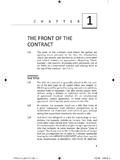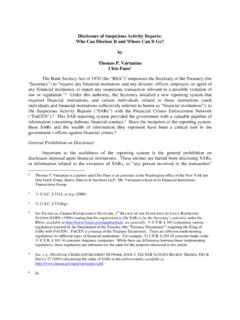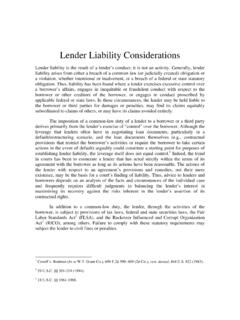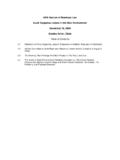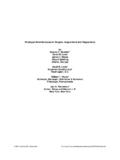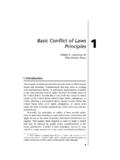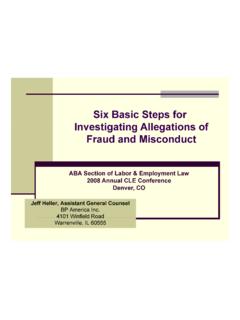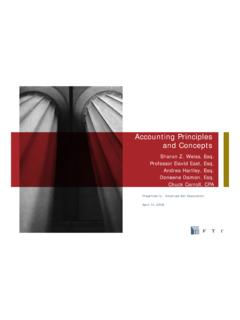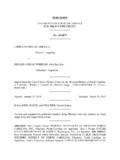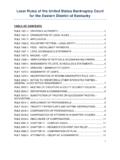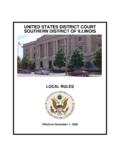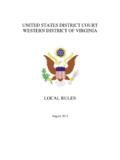Transcription of JUSTICE SYSTEMS IN CANADA AND THE UNITED STATES
1 Selina Koonar , , Candidate 1 JUSTICE SYSTEMS IN CANADA AND THE UNITED STATES Judicial independence as a prerequisite to JUSTICE is evident in both the Canadian and American legal SYSTEMS . Both CANADA and the UNITED STATES stem from the common law system . However, its JUSTICE SYSTEMS are very distinct. The Canadian judicial system is a unified system where all courts are part of the same system and the Supreme Court of CANADA has the final authority throughout CANADA . Conversely, the US has two parallel and sovereign judicial SYSTEMS where the federal JUSTICE system applies federal law and the state SYSTEMS are sovereign over the interpretation of state law.
2 The supreme law in both CANADA and the is its Constitutions. CANADA s Constitution is a combination of both codified and uncodified acts, conventional practices, and traditions. The Constitution Act 1867, originally the British North America Act, provides the core of the Canadian Constitution. It describes the structure and workings of government at the federal and provincial levels, among other things. The Constitution Act 1982 includes the Charter of Rights and Freedoms which functions as an entrenched bill of rights, is also an integral part of CANADA s Constitution. Because it has a long and storied history as a member of the Commonwealth, CANADA s legal system is solidly embedded in the British common law tradition.
3 However, Quebec has its own separate history as a French colony which makes it a special case in many aspects of law, and to this day it retains a unique civil system for handling issues of private law. Both Canadian legal SYSTEMS are subject to, and protected by, the Constitution of CANADA . The law of the was also originally largely derived from the common law system of English law, which was in force at the time of the Revolutionary War. However, the supreme law of the land is the UNITED STATES Constitution and, under the Constitution's Supremacy Clause, laws enacted by Congress and treaties to which the is a party.
4 These form the basis for federal laws under the federal constitution in the UNITED STATES , circumscribing the boundaries of the jurisdiction of federal law and the laws in the fifty STATES and in the territories. While CANADA and the both stem from the English common law system , its JUSTICE SYSTEMS are very distinct. The Canadian court system is made up of many courts differing in levels of legal superiority and separated by jurisdiction. Some of the courts are federal in nature while others are provincial or territorial. This intricate interweaving of CANADA s federal and provincial powers is typical of the Canadian constitution.
5 Generally speaking, CANADA s court system is a four-level hierarchy. Each court is bound by the rulings of the courts above them; however, they are generally not bound by their own past rulings or the rulings of other courts at the same level in the hierarchy. The Canadian constitution gives the federal government the exclusive right to legislate criminal law while the provinces have exclusive control over civil law. The provinces have jurisdiction over the administration of JUSTICE in their territory. Almost all cases, whether criminal or civil, start in provincial courts and may be eventually appealed to higher level courts.
6 The quite small system of federal courts only hear cases concerned with matters which are under exclusive federal control, such as immigration. The court system is quite complicated. While the Constitution STATES that federal law overrides state laws where there is a conflict between federal and state law, state courts are not subordinate to federal courts. Rather they are two parallel sets of courts with different, and often overlapping, jurisdictions. State courts SYSTEMS always contain some courts of general jurisdiction. All disputes which are capable of being brought in courts, arising under state or federal law maybe brought in one of the state courts, except in a few narrow cases where the federal law specifically limits jurisdiction exclusively to the federal courts.
7 Unlike state courts, federal courts are courts of limited jurisdiction, which can only hear the types of cases specified in the Constitution and federal statutes (mainly federal crimes, cases arising under federal law and cases involving a diversity of citizenship between the parties). Furthermore, Selina Koonar , , Candidate 2 federal courts must defer to state courts in their interpretation of state laws. The Supreme Court may review the final decision of state courts, after a party exhausts all remedies up to a request for relief from the state s highest appellate court, if the JUSTICE believes that the case involves a question of constitutional or federal law, or a criminal case is the federal wit of habeas corpus.
8 Another main difference between the CANADA and JUSTICE SYSTEMS are the selection of judges. In CANADA , judges are appointed by the government, not elected. Judges of the Supreme Court of CANADA , the federal courts, the appellate courts and the superior-level courts are appointed by the federal government. The federal government appoints and pays for both the judges of the federal courts and the judges of the superior-level court of each province. The provincial governments are responsible for appointing judges of the lower provincial courts. In many American jurisdictions, judges are elected. In some cases, the elections are partisan, where the nominee is affiliated and supported by a political party.
9 Others are not. Each state court system has different rules for the purpose of electing judges as well. In California, for instance, any qualified lawyer can run for judicial office at election time. The process is non-partisan. If a vacancy arises between elections, the governor appoints the judge. While the election of judges keeps the administration of JUSTICE consistent with prevailing social ideal, this system comes with many problems, particularly if the elected judge makes decisions for the vote. There are Canadians who would like to see their judges be elected as is the case for some American judges; however, there is no indication that the longstanding British tradition of appointing judges will be altered in CANADA anytime soon.
10 It is doubtful if an elected judiciary would be consistent with the Canadian constitution. Those who favor the appointment method point out that the election approach could possibly threaten the judiciary's ability to be independent in its decision-making. Though political patronage has certainly been a factor in the appointment of some judges, judges appointed to the Supreme Court of CANADA have been remarkably non-partisan and well respected by Canadians of all political stripes. Finally, it should be noted that CANADA s legal system is quite open to using case precedents from both England and the UNITED STATES when there are insufficient ones in the realm of Canadian law.


